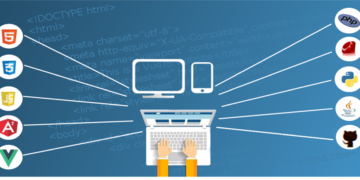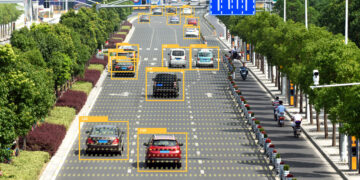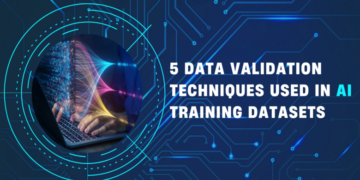Data annotation serves as a crucial element in the development of autonomous vehicle (AV) navigation systems. It involves the careful process of labeling data—including images, videos, LiDAR scans, and sensor readings. Cameras mounted on the vehicle capture images and videos, which are then annotated to identify objects like cars, pedestrians, and road signs. Similarly, LiDAR sensors generate 3D point clouds that are labeled to distinguish various objects and their distances, giving the vehicle a three-dimensional understanding of its environment. These detailed and accurately labeled training datasets for autonomous driving systems assist them in making informed decisions in real time.
Read through and discover more about data annotation and its indispensable role in the development and deployment of autonomous vehicles.
The Importance of Data Annotation in Empowering Autonomous Vehicle Navigation
1. Enhancing Localization and Mapping for Precise Navigation:
Localization (knowing the exact position) and mapping are very important for autonomous vehicles to navigate safely on roads. Data annotation plays a major role in enabling these capabilities. To localize, vehicles compare their sensor data against detailed high-definition (HD) maps containing information about static things in the environment, like lane markings, road signs, and landmarks.
Data annotators label these static elements, and this data is then used to create rich HD maps of the environment. During navigation, the vehicle’s perception system matches the elements it detects to those annotated on the map to accurately determine its precise location. The annotated maps also provide crucial details for planning routes and making driving decisions by including information about road layouts, intersections, and traffic signals along routes. As environments change over time, fresh annotated data is used to update the maps.
2. Ensuring Safety in Autonomous Driving Systems:
Ensuring safety is paramount for autonomous vehicles. Data annotation contributes to this by enabling the system to learn and handle rare and potentially hazardous situations. For instance, during data labeling, annotators might highlight examples of emergency vehicles, accidents, or debris on the road. By training on such annotated data, the navigation system can better anticipate and respond to these scenarios, improving overall safety. Additionally, during annotation, labeling of traffic signboards, such as stop signs, yield signs, and speed limits, is also considered. Accurate identification and understanding of traffic signs are essential for maintaining traffic law compliance and ensuring safe driving decisions.
3. Enabling Multi-Modal Perception through Comprehensive Annotation:
Data annotation contributes to improving AVs’ perception accuracy and adaptability by annotating data from multiple sensor modalities. This comprehensive annotation enables AVs to gain a more holistic view of their surroundings, improving their robustness and reliability in various environmental conditions, such as low visibility due to fog or heavy rain.
For instance, LiDAR scans provide information about object shapes and distances. On the other hand, radar sensors can detect objects through obstacles and adverse weather conditions. These different sensor types complement each other, resulting in a more accurate perception of the environment. Similarly, ultrasonic sensors can assist in nearby obstacles and road object recognition, further enhancing AVs’ perception capabilities, especially in close-range situations such as parking or navigating through tight spaces.
Also, read: Annual Maintenance Service Hong Kong company
4. Facilitating Continuous Improvement of Navigation Algorithms:
As the vehicle collects more data from various driving scenarios, annotators continuously label this new data to identify any anomalies, edge cases, or unexpected behaviors. This process allows developers to update and refine the algorithms regularly. For example, if a vehicle encounters a previously unseen type of road construction, annotators can label the relevant elements, such as temporary barriers or workers, during sensor data annotation. This annotated data can then be used to update the models, improving their ability to handle similar situations in the future.
Additionally, data annotation helps in tracking the performance of navigation algorithms over time. By comparing the system’s responses to annotated data before and after updates, developers can assess the effectiveness of improvements and identify areas that still need enhancement.
5. Supporting Regulatory Compliance:
Data annotation ensures that AVs adhere to regulatory standards and legal requirements in different regions and jurisdictions. By annotating data related to traffic laws, road signage, and regulatory zones, AVs can comply with local regulations and operate safely and legally on public roads, contributing to overall traffic safety and harmony.
Accessing High-Quality Training Datasets for Autonomous Driving Systems through Data Annotation Services
While data annotation plays a vital role in enabling autonomous vehicle navigation, annotating the massive volumes of data required to train these systems is an immense challenge.
In-house data annotation demands specialized skills, expertise, and dedicated resources. Organizations need to hire and train annotators proficient in labeling different data types like images, point clouds, and videos. They also require robust annotation tools and quality assurance processes to ensure annotation accuracy and consistency. This in-house approach can be time-consuming, costly, and distracting from an organization’s core focus – developing and refining the autonomous driving system itself. Scaling annotation efforts as data needs grow can further compound these challenges.
To overcome these hurdles, many autonomous vehicle companies are turning to data annotation service providers. By outsourcing annotation needs, companies can directly access high-quality, reliably annotated datasets tailored for autonomous driving use cases.
Service providers employ teams of seasoned annotators skilled in video, text, and image annotation services. They deeply understand the nuances and criticality of annotated data for training safe and reliable autonomous driving models. Experts stay updated on evolving annotation requirements, tools, and best practices to deliver future-proof datasets.
Moreover, partnering with annotation experts allows organizations to focus their resources on their primary mission – advancing autonomous vehicle technology through software development, testing, and systems integration.
On a Concluding Note
As the complexity of autonomous driving tasks increases, so does the demand for high-quality training datasets. Organizations striving to develop cutting-edge autonomous vehicle technology must ensure that their training data is accurate, diverse, and comprehensive. For organizations seeking foolproof, reliable datasets, opting for data annotation services emerges as a strategic choice. By leveraging third-party expertise, autonomous vehicle companies can accelerate their development timelines, ensure training data quality, and concentrate on core innovation – ultimately bringing autonomous driving technology to market faster and more efficiently.




































